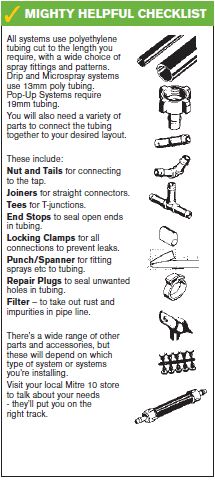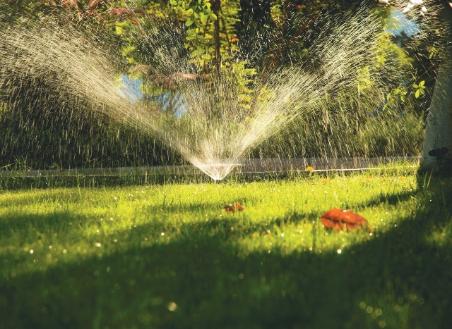INSTALLING A GARDEN WATERING SYSTEM
By Paul Johnson
As the spring season throws its customary mood swings one thing is becoming increasingly apparent; Summer is coming! With the bureau predicting a 70percent chance of exceeding the average min temperature this summer, don’t expect any respite for yourselves or your garden, so now is the time to plan ahead. With this in mind we will focus this issue on how to install a garden saving watering system so that your garden and lawns can flourish in the summer heat.
Irrigation fittings come in various shapes and flow rates so the first thing to do before you start is to measure the flow in litres per second from the garden tap. This may sound like an unnecessary step but if your tap only provides 20 litres per minute and you direct five 10 litre per minute sprays your system will be a waste of time and effort.
To do this turn off all the taps in your home and then turn one garden tap on full straight into a 9 litre bucket. Time how long it takes to fill the bucket in seconds then divide the bucket size by the time to fill and multiply by 60. This will give you your total flow rate in litres per minute.
The next step is to consider what type of system is most appropriate for you from the choice of three; dripper, microspray, and pop-up.
DRIPPER systems direct exactly the right amount of water for your plants directly to the soil. These are chosen based on the soil type and density. The general rule of thumb is to provide 1 dripper for every 50cm of foliage in normal soils, or 1 for every 35cm in sandy and other fast draining soils.
Microspray systems are the most popular and deliver a mist or spray. They are available in quarter, half, and full circles to enable you to prevent wastage and overspray into areas that don’t require water (for example that mossy path). They also prevent soil compaction and soil runoff as they provide a light spray directly to the foliage.
Pop up systems are primarily designed for even and efficient watering of lawns. They are available in quarter, half, three-quarter, and full circle sprays and save serious time and effort when compared to moving an individual hose mounted sprinkler around the lawn.
Once you have picked your appropriate system the fun can begin! Draw out a plan of your garden and measure out each section to calculate the length of tubing required. Aim to use one main line with smaller diameter tubing coming off it into the required garden beds. The staff at Johnson Brothers can help you to choose this tubing and the required connectors and clamps.
Using your plan, lay out all the parts where you intend to install them. Use bricks or stakes to hold the poly tubing in position and then adjust the layout from the tap outwards until the main tubing and distribution lines are suitably located. Connect all tubing with joiners, elbows or tees to form the desired layout then secure each connection with a locking clamp. For Drip and Spray systems, seal the open end with an end stop then cover the tubing with soil leaving the drippers exposed. For Micro spray systems, screw the spray head into the top of a riser tube then puncture the poly tubing and screw in the adaptor end of the riser. Stakes are available to give risers extra support.
With pop up systems it’s vital that your planned sprayers cover all areas of the lawn, if they don’t it will become patchy. Pop ups should be spaced approximately 3.6 meters apart, and the tubing should be buried 15-20cm bellow the surface of the soil. Cut the tubing and insert a threaded tee at the place where the pop-ups are required. Use a threaded elbow for the last pop-up and be sure to secure each connection with a locking clamp to prevent leaking. Screw on the pop-up sprinklers, making sure they are level with the ground, cover the tubing with soil and connect to the garden tap.
You can save yourself even more time and effort by running a simple tap timer!
All products are available at Johnson Brothers Mitre10 and the staff has an intimate knowledge of the systems for anyone who requires further information.


